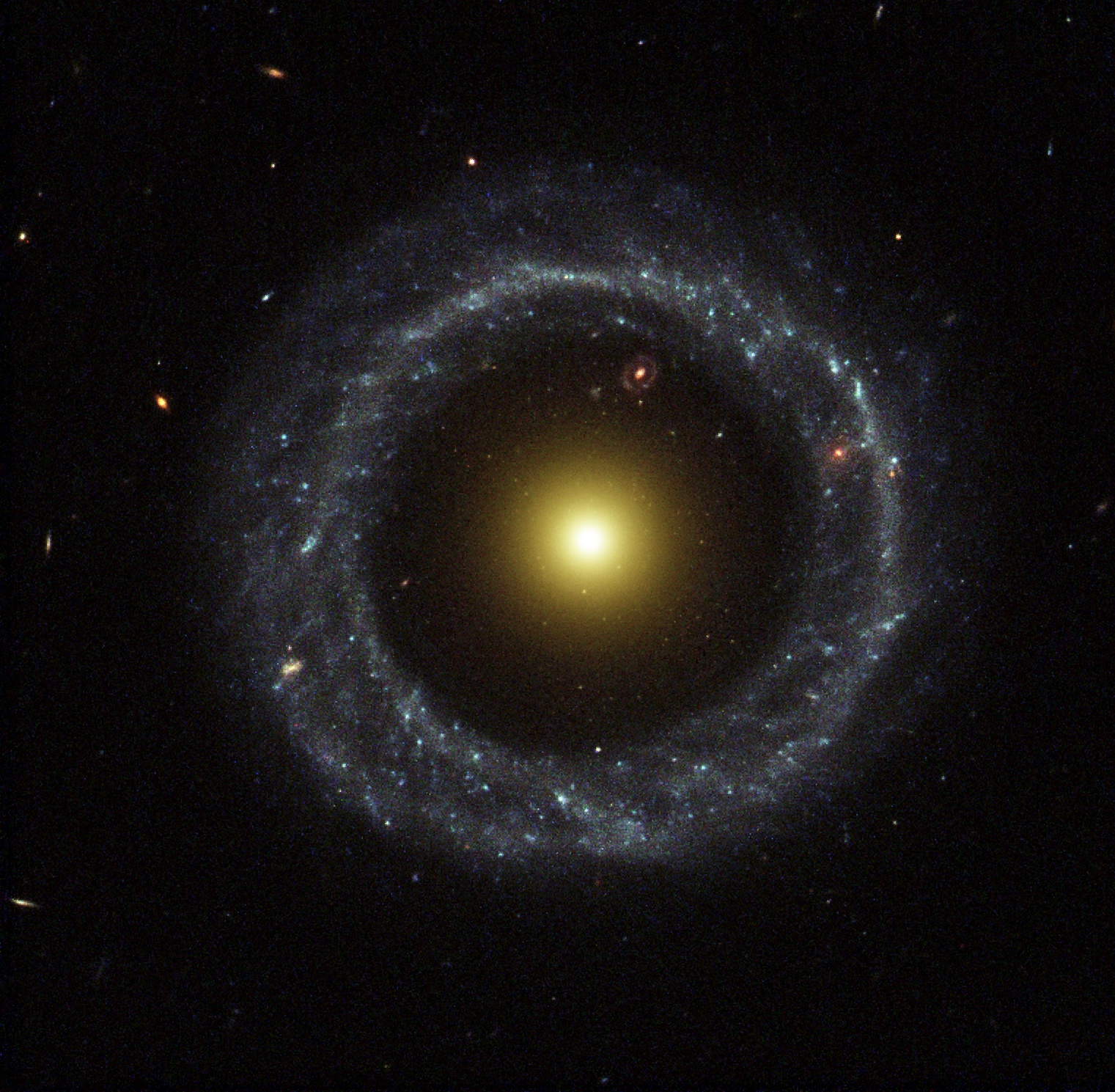I spent about half the period trying to get onto my account, so here goes:
An active galactic nucleus (AGN) is a compact region at the centre of a galaxy which has a much higher than normal luminosity over some or all of the electromagnetic spectrum (in the radio, infrared, optical, ultra-violet, X-ray and/or gamma ray wavebands). A galaxy hosting an AGN is called an active galaxy. The radiation from AGN is believed to be a result of accretion on to the supermassive black hole at the centre of the host galaxy. AGN are the most luminous persistent sources of electromagnetic radiation in the universe, and as such can be used as a means of discovering distant objects; their evolution as a function of cosmic time also provides constraints on cosmological models.
In summation, the term active galaxies is used to describe galaxies that, in all spectrums, have an extremely bright core area.

It is convenient to divide AGN into two classes, conventionally called radio-quiet and radio-loud. In the radio-loud objects a contribution from the jet and the lobes it inflates dominates the luminosity of the AGN, at least at radio wavelengths but possibly at some or all others. Radio-quiet objects are simpler since jet and jet-related emission can be neglected.
AGN terminology is often confusing, since the distinctions between different types of AGN sometimes reflects historical differences in how objects were discovered or initially classified, rather than real physical differences.
[edit] Radio-quiet AGN
* Low-ionization nuclear emission-line regions (LINERs). As the name suggests, these systems show only weak nuclear emission-line regions, and no other signatures of AGN emission. It is debatable whether all such systems are true AGN (powered by accretion on to a supermassive black hole). If they are, they constitute the lowest-luminosity class of radio-quiet AGN. Some may be radio-quiet analogues of the low-excitation radio galaxies (see below).
* Seyfert galaxies. Seyferts were the earliest distinct class of AGN to be identified. They show optical nuclear continuum emission, narrow and (sometimes) broad emission lines, (sometimes) strong nuclear X-ray emission and sometimes a weak small-scale radio jet. Originally they were divided into two types known as Seyfert 1 and 2: Seyfert 1s show strong broad emission lines while Seyfert 2s do not, and Seyfert 1s are more likely to show strong low-energy X-ray emission. Various forms of elaboration on this scheme exist: for example, Seyfert 1s with relatively narrow broad lines are sometimes referred to as narrow-line Seyfert 1s. The host galaxies of Seyferts are usually spiral or irregular galaxies.
* Radio-quiet quasars/QSOs. These are essentially more luminous versions of Seyfert 1s: the distinction is arbitrary and is usually expressed in terms of a limiting optical magnitude. Quasars were originally 'quasi-stellar' in optical images, and so had optical luminosities that were greater than that of their host galaxy. They always show strong optical continuum emission, X-ray continuum emission, and broad and narrow optical emission lines. Some astronomers use the term QSO (Quasi-Stellar Object) for this class of AGN, reserving 'quasar' for radio-loud objects, while others talk about radio-quiet and radio-loud quasars. The host galaxies of quasars can be spirals, irregulars or ellipticals: there is a correlation between the quasar's luminosity and the mass of its host galaxy, so that the most luminous quasars inhabit the most massive galaxies (ellipticals).
* 'Quasar 2s'. By analogy with Seyfert 2s, these are objects with quasar-like luminosities but without strong optical nuclear continuum emission or broad line emission. They are hard to find in surveys, though a number of possible candidate quasar 2s have been identified.
[edit] Radio-loud AGN
See main article radio galaxies for discussion of the large-scale behaviour of the jets. Here we discuss the active nuclei only.
* Radio-loud quasars. These behave exactly like radio-quiet quasars with the addition of emission from a jet. Thus they show strong optical continuum emission, broad and narrow emission lines, and strong X-ray emission, together with nuclear and often extended radio emission.
* 'Blazars' (BL Lac objects and OVV quasars). These classes are distinguished by rapidly variable, polarized optical, radio and X-ray emission. BL Lac objects show no optical emission lines, broad or narrow, so that their redshifts can only be determined from features in the spectral of their host galaxies. The emission-line features may be intrinsically absent or simply swamped by the additional variable component: in the latter case, it may become visible when the variable component is at a low level (Vermeulen et al. 1995). OVV quasars behave more like standard radio-loud quasars with the addition of a rapidly variable component. In both classes of source, the variable emission is believed to originate in a relativistic jet oriented close to the line of sight. Relativistic effects amplify both the luminosity of the jet and the amplitude of variability.
* Radio galaxies. These objects show nuclear and extended radio emission. Their other AGN properties are heterogeneous. They can broadly be divided into low-excitation and high-excitation classes ( Hine & Longair 1979; Laing et al. 1994). Low-excitation objects show no strong narrow or broad emission lines, and the emission lines they do have may be excited by a different mechanism (Baum, Zirbel & O'Dea 1995). Their optical and X-ray nuclear emission is consistent with originating purely in a jet ( Chiaberge, Capetti & Celotti 2002; Hardcastle, Evans & Croston 2006). They may be the best current candidates for AGN with radiatively inefficient accretion. By contrast, high-excitation objects (narrow-line radio galaxies) have emission-line spectra similar to those of Seyfert 2s. The small class of broad-line radio galaxies, which show relatively strong nuclear optical continuum emission (Grandi & Osterbrock 1978) probably includes some objects that are simply low-luminosity radio-loud quasars. The host galaxies of radio galaxies, whatever their emission-line type, are essentially always ellipticals.

A portion of the galaxies we can observe are classified as active. That is, a significant portion of the total energy output from the galaxy is emitted by a source other than the stars, dust and interstellar medium.
The standard model for an active galactic nucleus is based upon an accretion disc that forms around a supermassive black hole (SMBH) at the core region. The radiation from an active galactic nucleus results from the gravitational energy of matter as it falls toward the black hole from the disc.[48] In about 10% of these objects, a diametrically opposed pair of energetic jets ejects particles from the core at velocities close to the speed of light. The mechanism for producing these jets is still not well-understood.[49]
A jet of particles is being emitted from the core of the elliptical radio galaxy M87 (NASA/ESA Hubble Space Telescope image).
A jet of particles is being emitted from the core of the elliptical radio galaxy M87 (NASA/ESA Hubble Space Telescope image).
Active galaxies that emit high-energy radiation in the form of x-rays are classified as Seyfert galaxies or quasars, depending on the luminosity. Blazars are believed to be an active galaxy with a relativistic jet that is pointed in the direction of the Earth. A radio galaxy emits radio frequencies from relativistic jets. A unified model of these types of active galaxies explains their differences based on the viewing angle of the observer.[49]
Possibly related to active galactic nuclei (as well as starburst regions) are low-ionization nuclear emission-line regions (LINERs). The emission from LINER-type galaxies is dominated by weakly-ionized elements.[50] Approximately one-third of nearby galaxies are classified as containing LINER nuclei.[48][50][51]
The Galaxy class is a fictional class of starship in the science fiction franchise Star Trek. The most notable Galaxy-class starship is the USS Enterprise-D, the primary setting of Star Trek: The Next Generation. Star Trek creator Gene Roddenberry stated that only six Galaxy-class starships had been constructed,[1] and the USS Yamato is the only other Galaxy-class vessel to appear in The Next Generation. Several additional Galaxy-class ships appear in Star Trek: Deep Space Nine and Star Trek: Voyager.
Design and construction of the Galaxy-class began in the 2340s, with the first ships being commissioned in the 2360s.[2] According to dialog in the Next Generation episodes "11001001"[3] and "Booby Trap"[4], designers of the USS Enterprise-D included Orfil Quinteros and Leah Brahms.[1]
The ship's design features a saucer section connected via a vertical pylon to the stardrive section. Affixed to the rear of the stardrive section are two pylons, and atop each is a warp nacelle.
In real life, the Galaxy-class was designed by Andrew Probert for Star Trek: The Next Generation.[1] Interiors were designed by Probert and Herman Zimmerman during the first season.[1] Richard D. James designed and rebuilt the sets for the remaining six years, while Zimmerman returned for Star Trek: Generations.[1]
Saucer separation
The Galaxy-class Enterprise is capable of saucer separation and subsequent re-docking, used sometimes for leaving the civilian population behind when the stardrive section goes into combat[2], as seen in the The Next Generation episodes "Encounter at Farpoint"[5] and "The Arsenal of Freedom"[6], for the additional combat advantage of having two separate vessels instead of one, as seen in "The Best of Both Worlds, Part II"[7], or as a lifeboat[2], as seen in the film Star Trek: Generations[8].
[edit] Command
The main bridge of the Galaxy-class Enterprise is located on deck 1. Three distinct Galaxy-class bridge variants have been seen: the Enterprise bridge in The Next Generation (which undergoes a redesign in the first two seasons), the Enterprise bridge in Star Trek: Generations[8], and the USS Odyssey bridge in the Star Trek: Deep Space Nine episode "The Jem'Hadar"[9]. The Galaxy-class Enterprise also has a secondary battle bridge on deck eight of the secondary hull for use when the ship has undergone a saucer separation. It is first seen in the TNG episode "Encounter at Farpoint" and again in "The Arsenal of Freedom", with an updated version appearing in "The Best of Both Worlds".
[edit] Science and research
The Galaxy-class Enterprise supports an array of scientific disciplines, with laboratories and departments devoted to stellar cartography, exobiology, cetology, astrophysics, cybernetics, archaeology, cultural anthropology, botany, hydroponics, and planetary geosciences.[2]
[edit] Tactical
Galaxy-class ships engage Cardassian Galor-class ships during Operation Return in 2374
Galaxy-class ships engage Cardassian Galor-class ships during Operation Return in 2374
The Galaxy-class Enterprise is armed with twelve Type X phaser arrays and three photon torpedo launchers, each capable of firing ten individual torpedoes at a time.[2] One phaser array is mounted on the "cobra head" of the secondary hull while a photon torpedo launcher is mounted on the ventral aft of the saucer; both are inoperative while the saucer and stardrive sections are docked.[2] The ship also has a high capacity shield grid[2] and, according to dialog in the Next Generation episode "Conundrum"[10], at least 275 photon torpedoes.
[edit] Transportation
The Galaxy-class Enterprise has at least six transporter rooms and twenty transporter systems.[2] The ship has one large main shuttlebay in the saucer section, supported by two smaller bays in the stardrive section.[2] The ship carries a variety of shuttlecraft and a captain's yacht.[2]
[edit] Medical and life support systems
The Galaxy-class Enterprise includes a sickbay and a number of labs and other medical facilities.[2] The shuttlebays, cargo bays, and other areas of the ship can be converted into triage wards[2]; such conversion of a cargo bay appears in the TNG episode "Ethics"[11]. Other areas, such as Ten-Forward, can serve as emergency shelters.[2] Such use of Ten-Forward occurs in the Next Generation episode "Disaster".[12]
[edit] Crew support
Various Next Generation episodes show that the Galaxy-class Enterprise has amenities such as holodecks,[5] a school,[13] a gymnasium,[14] amphitheaters,[15] and a bar.[16] According to "Encounter at Farpoint"[5], several Enterprise crewmembers' civilian family members are aboard, and some civilians work aboard the ship, such as the bartender Ben in "Lower Decks"[17] and botanist Keiko O'Brien in "Rascals"[18] and other episodes.







